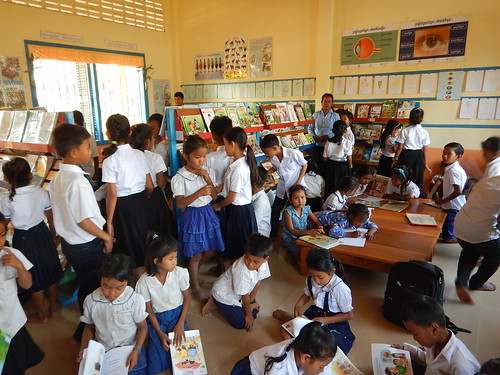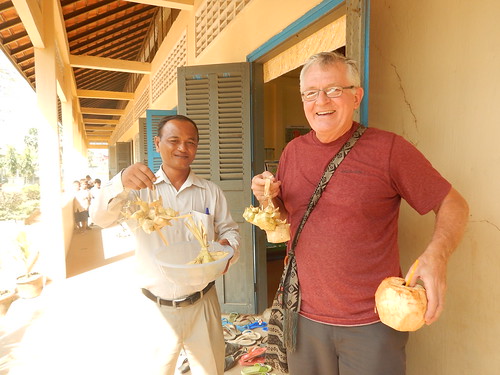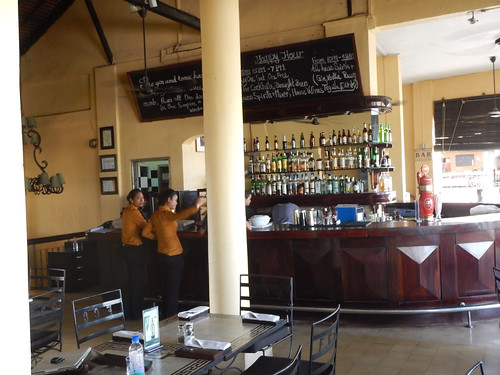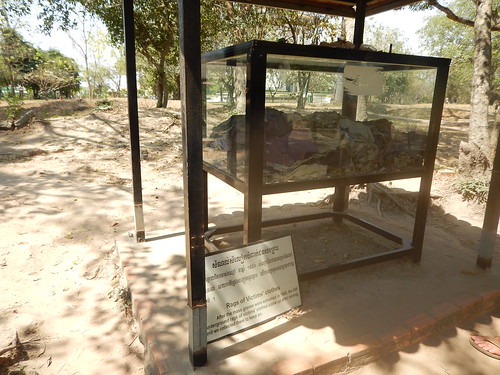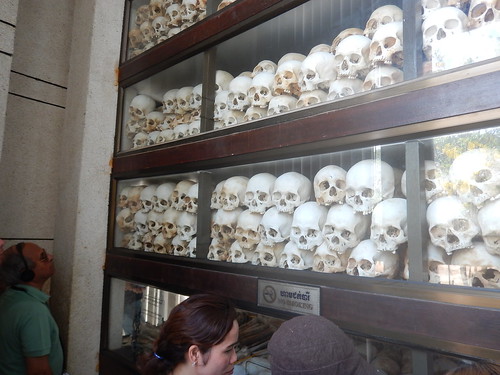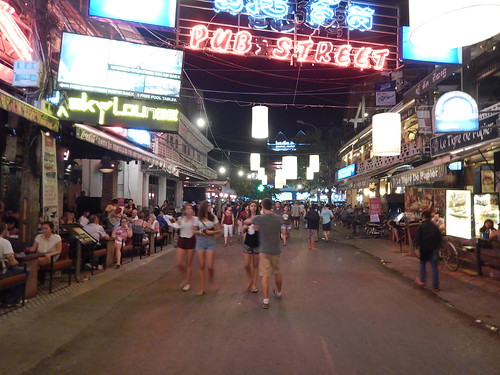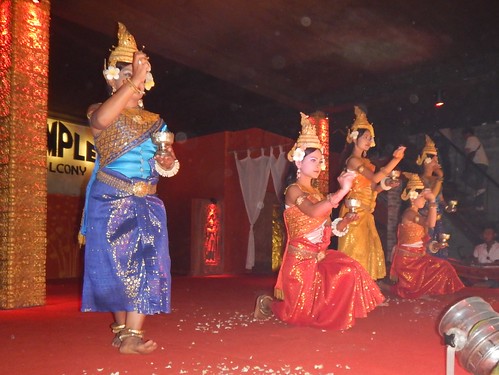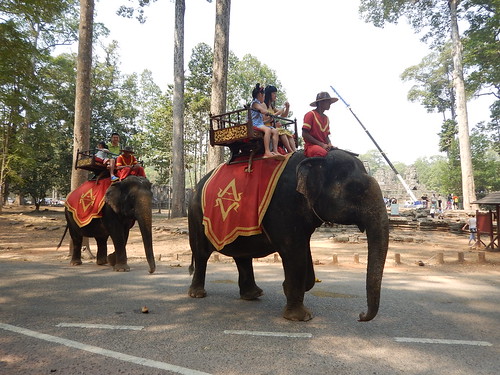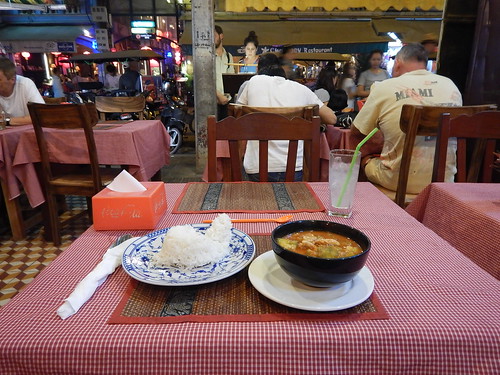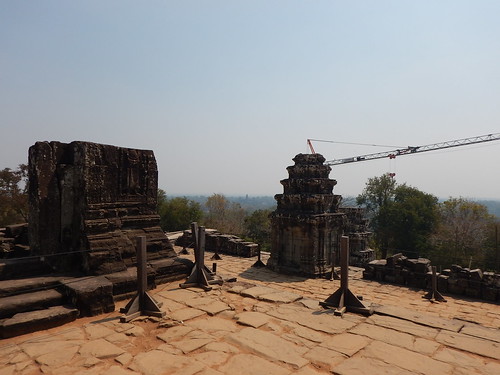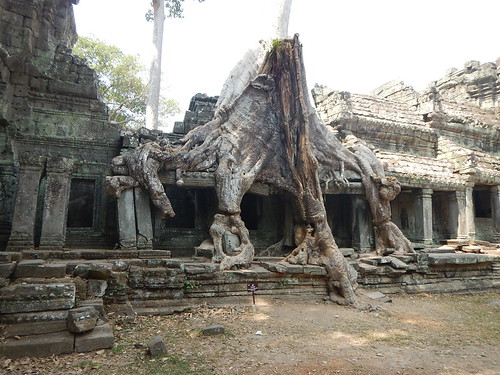I arrived early in the morning on the night bus from Sihanoukville to Siem Reap just as the sun was rising through the smoke and morning mist. I caught a moto-taxi to the Old Market area of Siem Reap to the Triangle Restaurant where I had breakfast before searching for a hotel.
Angkor Wat and me.
View from my sleep bus bunk bed
I was looking forward to getting to the hotel where I could shower and refresh myself before exploring the Old Quarter. After checking out a few places I ended up at the Neth Socheata Hotel. Since I was staying here for 4 nights, I bargained for a discount from $25 per night to $20 per night for a really nice top room floor with a view. It was clean and comfortable with TV---CNN so I could watch the NH primary returns as well as the debates---A/C, hot showers, and beautiful granite floors.
It was also located next to Psar Chaa---the public market.
At the nearby local market called Psar Chaa, I had this seamstress repair my ripped Hawaiian shirt---caught it on a branch during my Koh Rong hike---for $1USD.
Since this week is the Chinese New Years' holiday many of the tourists here are Chinese who generally are traveling in groups with their tour guides leading them with a flag. Pub Street is lined with bars and restaurants that cater to tourists where the menu choices are double that found in the Psar Chaa area except for the draft beer which is usually just 50 cents at either location.
The Temple Club is a multi-story affair with a restaurant and bar on the first floor, a nightly Aspara Traditional dance performance, and a rooftop lounge with live entertainment open to the night skies. The Aspara dance is very slow and deliberate with intricate hand, arm, and leg movements. I was told one time that this Aspara dance was this slow because when it was performed before the King any fast moves were viewed as an assassination threat to the King. Some performers were killed and that got the survivors to really slow down to avoid that fate.
The main reason for coming to Siem Reap was to view the nearby Angkor Wat monuments. On the second day, I caught a moto-taxi ride for $2 to take me out there. Unfortunately, this fellow did not realize that he needed to stop on the way in so I could purchase entrance tickets---3 days for $40. Instead, he dropped me off at the Bayon monument area which was about 6 km from the ticket booth.
The guard there told me I had to return to get a ticket. I started back and tried to get a ride from a moto-taxi for just $1 but none would stop. Then Bill--an Indian merchant, living here for 10 years--gave me a free ride to the ticket booth. After getting the ticket, I again tried to get a short ride to the main temple---Angkor Wat. After about 5 minutes a young Khmer motor-bike driver stopped for me and gave me a ride to Angkor Wat. On the way she pointed to where she lived. When she dropped me off, I offered to pay her $1, but she refused. She got a lot of kidding from the guys there. I really appreciate the unexpected kindness of strangers I meet along the way.
Angkor Wat temple complex was the first one I visited. This is the most popular and most often featured in any travel guide or photograph of this World Heritage site. I walked through it on my way to Ta Prohm, It turned out to be about a 2-hour walk by some of the lesser temples and many small restaurants along the way. I enjoyed the fresh coconut juice along with a cold Angkor Beer.


When I got to the East Gate of Tha Prohm, I pulled out some photos of a family I had met 10 years before and showed them to some of the vendors there. They told me that Mich and Thy were at the West Gate area. After walking through the now cordoned off Tha Prohm, I came to the West Gate vendor area and quickly had one of the vendors take me to Mich and Thy's shop of clothing and souvenirs.
The Mom, Mich, and Dad, Thy, were at the market, but the two children were there. The boy, Buntin, was now 16 and the girl, Panet, was now 14. I had some chicken Amok----meat and vegetable curry--- while waiting for Mich and Thy to return from the market.
Here is a picture of Buntin, Panet, and Mich from 10 years before.
When I had met them 10 years ago, I was having lunch at their restaurant when I heard some loud American guy arguing about the lunch bill. He had been sitting near me with about 8 of his traveling friends and had been bragging about how he had got a great cheap meal. It turned out that he had ordered vegetable noodle soup for $1.50 and then later added chicken. Mich had billed him $2 for the meal, and he was telling her that he was not going to pay the extra amount. After a few more of his insults to Mich, I told the guy he was an embarrassment to all other travelers. He still refused to pay, so I gave her $2 for his meal, and told him he should be ashamed of his behavior. I told his friends and girlfriend they should continue traveling without him. He then tried to give me the money, but I refused. As they left, you could tell that this guy had embarrassed them all, especially his girlfriend.
I then spent a bit of time with Mich and her family meeting them and taking their pictures. I also arranged for her husband, Thy, to motorbike me around to the other monuments. He would drop me off on one side and meet me on the other of these monuments for the next two days as well as pick me up and drop me off at my hotel in Siem Reap. In the intervening 10 years, they discontinued the restaurant but kept the clothing and souvenir shop and her father who I had met had died at just 65 years old.
This time, they invited me to their home at Angkor Wat which was adjacent to the Sa Srang--once a royal bathing pool. Once we were there, Mich and Thy began lighting the charcoal stoves, drawing well water, and preparing dinner. While they had me sit in the only big chair outside their house, they described how most of the surrounding homes were their relatives' homes. Sure enough, as they continued preparing the dinner, I met more and more brothers and sisters and children of their extended family joining them for dinner.

They had placed a mat out on their patio where we would be having dinner on this mat. As the honored guest, I was the first one to eat. First came morning glory vines with all of the internal organs of the chicken cooked in it followed by taking a lettuce leaf and stuffing it with the rice pasta, pork--mostly fat, and then dipped it in sweet rice vinegar, red chilies, and peanut sauce. Everything was delicious although I did take very little of the organs.
Even the community representative joined us for dinner. I also noticed that several platters of food were being delivered to some of the elderly neighbors in the area. They also prepared a platter for an offering that her son and sister took to a nearby Khmer temple as an offering. Mich told me that this family compound had been in the family for so many generations, that they did not know when it began.
The kids enjoyed playing Fruit Ninja and Angry Birds on my mini iPad while we adults continued to eat and drink the cold Anchor beer. After dark, I told Mich and Thy that I should be heading back while Thy could still drive me back on the motorbike, or I would end up spending the night there.
After getting back to my hotel, I arranged for Thy to again tour me around by motorbike the following morning at 9AM.
With Thy driving me about, we first stopped at the Bayon with its many clusters of rounded heads decorating all of the temple spires.
It was then on to the Terraces of the Elephants.
Followed by the Terrace of the Leper King.
After lunch, we then headed to the distant Banteay Srey some 16 km away, Although smaller than the other major temples, this one used red stone with intricate Hindu carvings compared to the mostly Buddhist images found throughout the rest of Angkor Wat.
Upon returning to Siem Reap, I enjoyed eating Khmer food at one of the restaurants that bordered the Psar Chaa-- the public market.
Khmer chicken-eggplant curry with rice.
On my last day at Angkor Wat, I rented an electric bike to see some of the sites I had earlier missed and also some I wanted to see again.
I first stopped at the Phnom Bakheng which is a popular place for capturing sunset pictures of Angkor Wat. This site was under a major renovation.
I revisited the Angkor Wat, Bayon, and Terrace areas and then head back to the last look at Tha Prohm along with some of the lesser temples along the way.
Tha Prohm and the "Tomb Raider" entrance.
When I was here ten years ago, there were no wood walkways nor railings that limited where you could explore.
Next on to Phnom Penh by bus for a site visit to one of the Room to Read----www.roomtoread.org---activities in Cambodia.
Subscribe to my YouTube Channel
I have recently uploaded all of my travel videos to YouTube now that they allow longer uploads. I have also added other shorter travel videos.
That link is https://www.youtube.com/c/huntforgold
If you do go there, please subscribe to my video channel since it will help me eventually get some income there and help with my future travels.






